Special Feature: Products Sally Recommends
Tequila
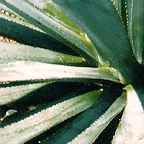 Tequila
is an undeniable part of modern pop culture, celebrated in song
by everyone from Steely Dan and the Eagles to the Rolling Stones
and Jimmy Buffet, as well as the subject of several recent books:
Maria's Real Margarita Book (Ten Speed Press) from the
Santa Fe, New Mexico, restaurant; Tequila! Cooking with the
Spirit of Mexico (Ten Speed Press); and Tequila, the Book
(Chronicle Books).
Tequila
is an undeniable part of modern pop culture, celebrated in song
by everyone from Steely Dan and the Eagles to the Rolling Stones
and Jimmy Buffet, as well as the subject of several recent books:
Maria's Real Margarita Book (Ten Speed Press) from the
Santa Fe, New Mexico, restaurant; Tequila! Cooking with the
Spirit of Mexico (Ten Speed Press); and Tequila, the Book
(Chronicle Books).
Spirits including vodka and gin strive for smoothness, for a gentle and almost neutral flavor that hides the taste of alcohol and the origin of the ingredients. Like fine brandies, the best tequilas aim to bring to the glass as much flavor from the plant and soil as possible -- what the French call "gout de terroire." Made in Mexico from the blue agave (which looks like an oversized aloe vera plant and is often mistaken for a cactus, but is actually a relative of the lily), tequila has earthy, herbaceous flavors that set it apart from all other spirits.
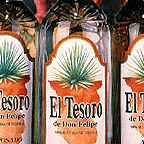 While
tequila has been around for more than 200 years, it is really
only since the introduction of the margarita in the '40s that
it has caught on in the United States. One of the most widely
repeated stories says that the margarita was created in Tijuana
by bartender Danny Herrera, after much experimentation, for a
favorite customer who couldn't drink vodka or gin. Her name was
Marjorie King, and Herrera named the drink for her in Spanish:
Margarita, a fortuitous meeting of tequila, Cointreau and lime
juice, a potent detente between sweet and sour, and a drink of
nearly universal appeal.
While
tequila has been around for more than 200 years, it is really
only since the introduction of the margarita in the '40s that
it has caught on in the United States. One of the most widely
repeated stories says that the margarita was created in Tijuana
by bartender Danny Herrera, after much experimentation, for a
favorite customer who couldn't drink vodka or gin. Her name was
Marjorie King, and Herrera named the drink for her in Spanish:
Margarita, a fortuitous meeting of tequila, Cointreau and lime
juice, a potent detente between sweet and sour, and a drink of
nearly universal appeal.
Due in large part to the margarita, tequila is one of the few spirits with rising sales. "Most spirits are either flat or declining, while tequila has grown six out of the last eight years," says Steve Barsby, an economist and alcohol beverage industry consultant. "Tequila is the only spirit continuing to show significant growth, and super- and ultra-premium tequilas are growing 15% per year," says Steve Goldstein, Vice President at Heublein Inc., importers of Jose Cuervo, which accounts for nearly half the five million cases of tequila sold in the United States annually. According to Goldstein, the United States consumes the most, gulping down 90% of exports; the margarita, which has ranked between first and third in popularity over the last few years among mixed drinks, is where two thirds of that tequila ends up. (In Mexico, tequila is most often served straight in special shot glasses, frequently accompanied by a side glass of sangrita, a spicy blend of orange and tomato juices and jalapenos.)
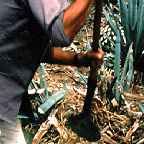 Tequila
is the oldest distilled spirit in the Americas. In 1519, when
the Spanish conquistadors arrived in Mexico, they found the natives
drinking pulque, a fermented agave beverage with a flavor somewhat
like coconut milk. The Spaniards, masters of the art of distillation,
distilled the pungent brew, creating tequila, also known at that
time as mezcal.
Tequila
is the oldest distilled spirit in the Americas. In 1519, when
the Spanish conquistadors arrived in Mexico, they found the natives
drinking pulque, a fermented agave beverage with a flavor somewhat
like coconut milk. The Spaniards, masters of the art of distillation,
distilled the pungent brew, creating tequila, also known at that
time as mezcal.
Today, tequila is undergoing another transformation, from the drink of choice of rowdy high school bacchanals to a sophisticated sipping beverage rivaling fine Scotches and brandies. Of course, these upscale tequilas cost quite a bit more than the typical "Gold," with prices ranging from about $30 to $75 per bottle. This generation of refined, super-premium tequilas is far removed from the throat-searing beverage of just a few years ago, as superior to them as Champagne is to cold duck.
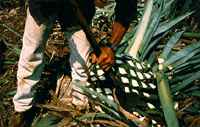 The
half dozen or so really good tequilas, including Centinela, Herradura,
El Tesoro and Chinaco, are like eau-de-vie infused with the delicate,
herbaceous essence of the agave, not the harsh, fiery taste of
alcohol or the thick, cloying flavors of caramel and other additives
that are found in low-priced bottles. As with wines, many exotic
flavors can be found in tequila -- agave, like grapes, is sensitive
to the land and environment in which it grows. It's not unusual
to find hints of everything from mushrooms and smoke to vanilla,
pepper and even mint in the best tequilas.
The
half dozen or so really good tequilas, including Centinela, Herradura,
El Tesoro and Chinaco, are like eau-de-vie infused with the delicate,
herbaceous essence of the agave, not the harsh, fiery taste of
alcohol or the thick, cloying flavors of caramel and other additives
that are found in low-priced bottles. As with wines, many exotic
flavors can be found in tequila -- agave, like grapes, is sensitive
to the land and environment in which it grows. It's not unusual
to find hints of everything from mushrooms and smoke to vanilla,
pepper and even mint in the best tequilas.
While the finest tequilas (approximately 1% of total production) are made from only the blue agave (labeled as "100% agave"), lower-quality bottles contain up to 49% added sugar. And that "Gold" is usually the result of added caramel, not oak ageing.
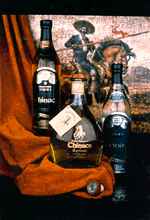 The
Mexican government strictly regulates the making of tequilas,
and four categories (listed in order of aging, not necessarily
quality) are recognized : white (or silver or plata), joven abocado,
which is silver with color and/or flavor added; reposado, aged
from two months to one year, in wood tanks (not steel); and anejo,
aged at least one year in sealed oak barrels. While aged tequilas
are almost always more expensive, many aficianados prefer the
silver because they taste more of the agave itself than of oak.
The region of production is limited, as with France's Cognac and
Armagnac, and anything produced outside the specified areas cannot
be labeled tequila. Mezcal (which sometimes includes a worm in
the bottle) now has its own government standards, defining where
and how it can be made, as well.
The
Mexican government strictly regulates the making of tequilas,
and four categories (listed in order of aging, not necessarily
quality) are recognized : white (or silver or plata), joven abocado,
which is silver with color and/or flavor added; reposado, aged
from two months to one year, in wood tanks (not steel); and anejo,
aged at least one year in sealed oak barrels. While aged tequilas
are almost always more expensive, many aficianados prefer the
silver because they taste more of the agave itself than of oak.
The region of production is limited, as with France's Cognac and
Armagnac, and anything produced outside the specified areas cannot
be labeled tequila. Mezcal (which sometimes includes a worm in
the bottle) now has its own government standards, defining where
and how it can be made, as well.
Wild and exotic claims are made for some tequilas. As many as 300 different bottles are available in Mexico (about 100 in the United States), but they all come from only three dozen or so distilleries. The government-issued "NOM" number on the front of the bottle tells where a tequila was made by indicating the distillery of its origin. Some so-called super-premiums purchase their liquor from run-of-the-mill distillers and then slap fancy labels on stylish bottles. The best bet is to find a hands-on, family-owned distiller who has been making high-quality tequilas for years, much as many of the world's best wines come from small, hands-on vineyards that are family owned). The 100% agave designation doesn't guarantee great tasting tequila, but most, if not all, of the best tequilas,both silver and anejo, are made this way -- with no additives or flavoring of any kind.
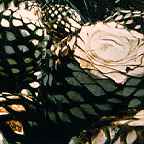 El
Tesoro de Don Felipe ("Don Felipe's Treasure") is produced
by a third generation, family-run distiller at La Altena, a veritable
working museum of tequila which uses the time-tested, old-fashioned
techniques at every step, including cooking the plants in small
brick ovens (known as hornos) rather than using more common autoclaves.
They grow all their own agave -- making this an "estate"
tequila -- in the Los Altos region of Jalisco, with about two
million plants in the ground at any one time, 7000 feet high up
in the mountains. The silver ($27) is bottled within 24 hours
of distillation to prevent oxidation, while the Anejo ($34), a
blend of two and three year old batches rested in bourbon barrels
from Kentucky, ages in a cellar where sprinklers maintain the
proper humidity. These artisan tequilas have delicate, floral
flavors, from the hint of eucalyptus and peppermint in the silver
to fruitiness and tobacco in the anejo.
El
Tesoro de Don Felipe ("Don Felipe's Treasure") is produced
by a third generation, family-run distiller at La Altena, a veritable
working museum of tequila which uses the time-tested, old-fashioned
techniques at every step, including cooking the plants in small
brick ovens (known as hornos) rather than using more common autoclaves.
They grow all their own agave -- making this an "estate"
tequila -- in the Los Altos region of Jalisco, with about two
million plants in the ground at any one time, 7000 feet high up
in the mountains. The silver ($27) is bottled within 24 hours
of distillation to prevent oxidation, while the Anejo ($34), a
blend of two and three year old batches rested in bourbon barrels
from Kentucky, ages in a cellar where sprinklers maintain the
proper humidity. These artisan tequilas have delicate, floral
flavors, from the hint of eucalyptus and peppermint in the silver
to fruitiness and tobacco in the anejo.
Named for the fighting Chinacos who defended Mexico during the Guerra de Reforma (War of Reform) in the 1850s and the French Intervention in 1863, Chinaco's ownership has passed from founder Guillermo Gonzales to his four sons. Like Cristal Champagne, Chinaco developed a rabid following and became the de rigeur tequila among Hollywood trendsetters before vanishing for a couple of years when the founder tired of the hard work and shut it down. Devoted fans have been waiting impatiently for production of this spicy and exotic tequila, which halted in the late '80s, to resume. Chincao Silver ($29), Reposado ($34) and Anejo just returned to the shelves after the sons of the founder bought it from him and resumed production.
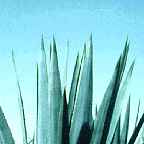 Sauza's
Hornitos is a highly regarded 100% agave reposado tequila, while
their earthy Commemorativo is an anejo of 51% agave. Tres Generaciones,
named for the three generations of the Sauza family, claims eight
years of ageing, more than double what most consider the optimal
time, but this straw-colored, mildly herbaceous tequila is unquestionably
a smooth and pleasant.
Sauza's
Hornitos is a highly regarded 100% agave reposado tequila, while
their earthy Commemorativo is an anejo of 51% agave. Tres Generaciones,
named for the three generations of the Sauza family, claims eight
years of ageing, more than double what most consider the optimal
time, but this straw-colored, mildly herbaceous tequila is unquestionably
a smooth and pleasant.
Patron, distributed by Seagram's, sells both silver ($32) and anejo ($37) bottles. Aged in white oak barrels, the anejo results from the blending of three batches of different ages. Patron is sold in beautiful, hand-blown bottles with colored glass stoppers, and the striking appearance of these bottles has contributed at least as much as the quality of the tequila itself to this brand's rise to the top. Likewise, Porfidio's top-of-the-line product, a smoky and exotic "Single Barrel" tequila, comes in a dazzling bottle distinguished by the presence of a glass cactus inside.
The newest entry on the ultra-premium market, a response to the soaring popularity of top-shelf tequilas like Patron and El Tesoro, is the 100% agave La Reserva de la Familia de Jose Cuervo. Cuervo is the biggest tequila producer, and is best known for its Especial, more commonly referred to as "Gold." But Cuervo makes several different bottles, from its herbaceous 100% agave Tradicional, a white reposado, to oaky Cuervo 1800, a blend of reposado and anejo tequilas. La Reserva, made at La Rojena, Cuervo's original distillery in the town of Tequila, is the only tequila, according to the manufacturer, to employ new oak barrels, not used Bourbon barrels, in the ageing process. Each bottle is individually numbered, corked, sealed with wax, and presented in a wood box; at $75, it is one of the most expensive tequilas ever made. La Reserva is incredibly smooth, dark and rich, bourbon-like, both in color and taste, from the deep-charred barrels. It may seem over-refined and far removed from tequila's earthy roots to those who appreciate the more raw flavors of tequila, while it may be the ideal style for those who often find the beverage too harsh.
Traditionally, it's been Southwestern and Mexican restaurants which have stocked a wide variety of tequilas. But these days a good selection of tequilas is as essential to any bar as are Scotches, Cognacs and bourbons. Even among wine lovers, there's a growing awareness and appreciation of fine tequilas. Larry Stone, Wine Director at Rubicon, one of San Francisco's top restaurants, stocks seven super-premium bottles. He's seen an increase in demand for superior varieties among his customers. "They're more and more interested in the smaller, higher quality producers," reports Stone, whose personal favorite is El Tesoro's silver. "The anejos are good, but the smoky flavor of non-oak aged tequilas is more animal, more wild and more satisfying. Long ageing in wood takes away from their nature and detracts from their quality," says Stone.
Los Angeles' Kachina Grill stocks as many as 42 different tequilas. But the true temple of tequila worship in the United States is unquestionably Left at Albuquerque, a southwestern-style restaurant in Palo Alto, Calfornia, which has 119 tequilas and more than half a dozen mezcals, all of which range from $3.50 to $13 per shot. Bar manager Kevin Wendland says, "We just bought everything possible." The menu boasts, "If you can find a tequila we don't have, we'll buy you a margarita!" Wendland's personal favorites are Centinela's three year old anejo, El Tesoro's anejo and Porfidio's "single barrel," while the most popular is Herradura's silver. Not every tequila at the bar is great, but Wendland thinks they're all worth trying, if only for comparison. Regulars join the "Emerson Agave Club," where sampling 50 different tequilas earns a t-shirt, sipping 65 rates a hat, 75 a free dinner and tasting every single one gets an invitation to the restaurant's upcoming open-bar one year anniversary party.
While tequila is most often ordered straight or blended in a margarita, two new drinks have recently cropped up. Cashing in on the national resurgence of the martini, there's the "Tequilatini," served at the Four Seasons New York's famous martini bar with chilled Jose Cuervo Especial, Grand Marnier, Cointreau and a slice of orange in a martini glass. And then there's the Jake, created by Jake Lorenzo, alter ego of Sonoma's Gundlach Bundschu winemaker, Lance Cutler. His libation, created in partnership with three bartenders at Seattle's Mayflower Park Hotel, which has won a local poll three years in a row for "Best Martini," calls for rinsing a glass with cabernet sauvignon, pouring in chilled tequila and garnishing with a curlicue of lime. The Jake is served at the Swiss Hotel in Sonoma, El Meson de Tequileros in Guadalajara, Rusty Staubs in New York and, of course, the Mayflower Park in Seattle.
"Tequila is comparable to Scotches, bourbons and brandies," says Cutler, a wine and spirits expert who is researching a book on tequila. Of the several different districts where agave can be grown, Cutler says you can taste the differences. "At their best, they're as distinctive as Scotches from different regions."
It's not surprising, given the ever-increasing popularity of tequila, that mezcal, too, has been getting a second look. Long considered the poor relative of tequila, mezcal may finally be coming into its own. Mezcal is to tequila as Armagnac is to Cognac -- less well known, more fiery and filled with more of the flavors of the plant and the soil. Both tequila and mezcal are distilled from the agave plant -- of which there are more than 300 varieties -- tequila from the blue agave, mezcal usually from the espadin. The agave for mezcal is roasted over charcoal, not baked in ovens, so it often has smokier flavors. Encantado mezcal ($40), which means "enchanted" or "bewitched," is the first super-premium mezcal available in this country, a slightly spicy and peppery blend of more than a dozen mezcals produced in palenques (small distillers) in remote villages around Oaxaca. It is catching on at trendy nightspots around the country, including Boulevard in San Francisco.
Almost everyone has some drink he or she has vowed never to touch again, the result of some particular overindulgence in school days. If you haven't tried tequila or mezcal in years, you don't know what you're missing.
Note: This information was accurate when it was published. Please be sure to confirm all rates and details directly with the businesses in question before making your plans.



